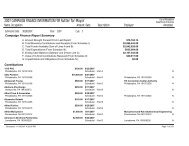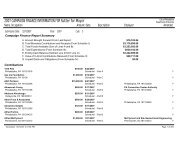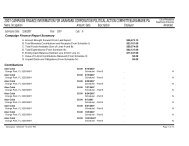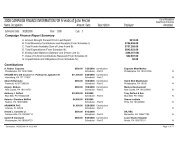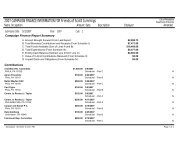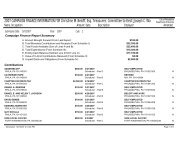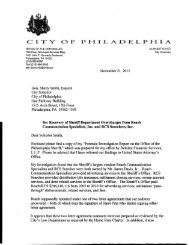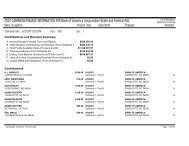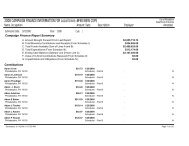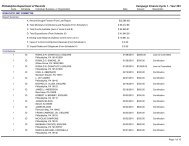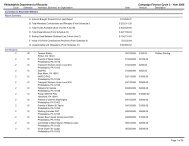department of revenue tax discovery program action steps to
department of revenue tax discovery program action steps to
department of revenue tax discovery program action steps to
You also want an ePaper? Increase the reach of your titles
YUMPU automatically turns print PDFs into web optimized ePapers that Google loves.
FINDINGS AND RECOMMENDATIONS<br />
IRS stands at the leading edge <strong>of</strong> using data analysis. It believes data<br />
analysis allows the legislative and executive branches <strong>of</strong> the federal<br />
government <strong>to</strong> make better decisions about <strong>tax</strong> policy and the<br />
allocation <strong>of</strong> resources for <strong>tax</strong> administration. Not only has IRS<br />
estimated the <strong>to</strong>tal <strong>tax</strong> gap as $345 billion, but also the agency has<br />
dissected components <strong>of</strong> the gap in<strong>to</strong> three major categories<br />
(nonfiling - $27 billion; underreporting - $285 billion; and<br />
underpayment - $33 billion). IRS further examined the<br />
underreporting component and estimated the composition by major<br />
<strong>tax</strong> types (individual income <strong>tax</strong> - $197 billion; employment <strong>tax</strong> - $54<br />
billion; corporation income <strong>tax</strong> - $30 billion; estate and excise <strong>tax</strong>es -<br />
$4 billion), and within <strong>tax</strong> type by underreported class <strong>of</strong> income (or<br />
overstated adjustment, deduction, exemption, and credit) payroll-<strong>tax</strong><br />
type, or corporation size (large or small).<br />
Armed with the above information, IRS developed a comprehensive<br />
strategy <strong>to</strong> reduce the gap. The strategy included legislative changes,<br />
as well as better-targeted enforcement and increased outreach efforts<br />
<strong>to</strong> help <strong>tax</strong>payers understand their obligations.<br />
Of other <strong>tax</strong> agencies we surveyed, California and Washing<strong>to</strong>n s<strong>to</strong>od<br />
out as leaders in using data analysis <strong>to</strong> drive the focus <strong>of</strong> their <strong>tax</strong><br />
<strong>discovery</strong> efforts. California, for example, quantified its state income<br />
<strong>tax</strong> gap at $6.5 billion annually. It looked at trends identified by the<br />
IRS and made assumptions about how these trends might apply <strong>to</strong> the<br />
state. It had determined that 43 percent <strong>of</strong> non-filers were wage<br />
earners. Knowing wage earners made up a significant percentage <strong>of</strong><br />
non-filers, California’s <strong>tax</strong> agency contacted the state-level<br />
Employment Development Department and shared that <strong>department</strong>’s<br />
“New Employee Registry.” As a result, the <strong>tax</strong> agency routinely<br />
began identifying and garnishing wages <strong>of</strong> delinquent <strong>tax</strong>payers soon<br />
after they started a new job.<br />
The state <strong>of</strong> Washing<strong>to</strong>n used data analysis <strong>to</strong> identify potentially<br />
86,000 personal services firms that were not paying an estimated $24<br />
million in use <strong>tax</strong>. This knowledge drove the Washing<strong>to</strong>n State<br />
Department <strong>of</strong> Revenue <strong>to</strong> strategize a two-phased plan that included<br />
a special educational notice about the <strong>tax</strong>, and then a more<br />
personalized follow-up letter with an interactive voice mail system<br />
established so <strong>tax</strong>payers who owed no use <strong>tax</strong> could respond.<br />
Findings<br />
The DOR has not used data analysis <strong>to</strong> formally develop and adopt a<br />
strategic plan for <strong>tax</strong> <strong>discovery</strong>. We observed no analyses<br />
documenting the types <strong>of</strong> <strong>tax</strong>able entities, sorts <strong>of</strong> industries, or other<br />
categorizations that may comprise the City’s <strong>tax</strong> gap. Quantifying the<br />
City’s <strong>tax</strong> gap was not within the scope <strong>of</strong> this audit project, and<br />
4



